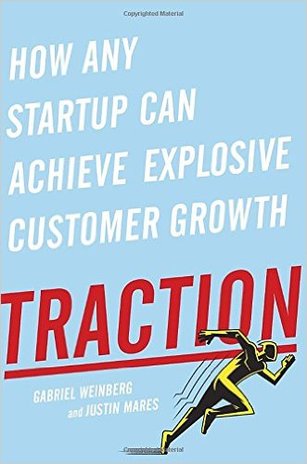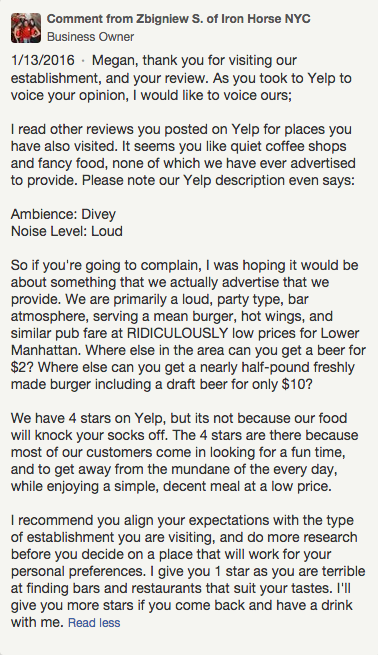|
There's no part of the business world that's evolving faster than marketing. Fifteen years ago, websites were just online brochures. Ten years ago, SEO was a brand new concept. Five years ago, free-to-play, the sharing economy, and content marketing--to name just a few--didn't exist. Marketing is experiencing "disruptive innovation" on steroids, which is why it's essential for entrepreneurs and marketers alike to keep abreast of the new ideas and techniques that continue to emerge. These five newly-published books are the best and most essential of the hundreds of marketing books published this year: 1. Ask
2. Traction
3. DotCom Secrets
4. The Membership Economy
5. The Content Code
By Brain Koerber On Jan 19, 2016 Think twice before you write a bad Yelp review for the Iron Horse in New York City, they may just put you in your place. After a Yelper had an unfavorable experience at a dive bar in Lower Manhattan, she took to Yelpin order to vent some of her frustrations, leaving the Iron Horse with a one-star review. An unfavorable review can be damaging for any business, so the bar's owner responded. He explained why arriving at a one-star review was a bit unfair considering the reviewer's reasons. The Yelper was looking for a quiet place to have a drink with friends. However, dive bars are known for being cheap and rowdy. They're the kind of place where you can spill your drink and no one will look twice, somewhere you can make a total ass of yourself and be welcomed back the next night with a pickelback. To be fair, the Yelper complained about poor service and bad food, but again, dive bars aren't exactly well known for their service or their upscale dining experience. Iron Horse's owner did a little bit of Yelp sleuthing and discovered that the Yelper typically visited quiet cafés. So, he quickly pointed out that his bar prides itself on its loud ambiance. "We have four stars on Yelp, but it's not because our food will knock your socks off," the owner explained. "The four stars are there because most of our customers come in looking for a fun time and to get away from the mundane of the every day, while enjoying a simple, decent meal at a low price."
The owner finished by suggesting that the patron align her expectations with the type of establishment she's visiting. He then gave her a one-star rating, which could go up if she came back to have a drink with the owner. Source: http://mashable.com/2016/01/19/dive-bar-yelp/#WgR98mab7OqX By KIM SEVERSON On JAN. 11, 2016 A cake posted to the private Instagram account of Neal McCarthy, an owner of the Atlanta restaurant Miller Union. Cakes are meaningful, so it is no surprise that people sometimes bring them along to a restaurant as a celebratory coda to a special meal. And it’s no surprise that restaurants don’t always like it. So restaurants often charge customers to cut and plate the cake. Sometimes they add a scoop of ice cream. The practice has come to be called cakeage. It’s a play on corkage, the fee a restaurant levies to open a bottle of wine brought by the customer. Neal McCarthy, who owns the Atlanta restaurant Miller Union with the chef Steven Satterfield, takes things a step further. His private Instagram account is filled with photographs of cakes customers have carried into Miller Union. He pokes fun at grocery store monstrosities and cakes fashioned from chocolate chip cookie dough, cracking wise about garish icing and other questionable decorative choices. “It’s like my comic relief and my only way of getting back at people, even though I do it secretly,” Mr. McCarthy said. “These people sought out a nice restaurant, yet they undermine it by bringing in the world’s most hideous cakes.” Another cake from Mr. McCarthy's Instagram feed. CreditNeal McCarthy Like many in the business, he views the practice of taking cake to a restaurant that employs a pastry chef an abomination. “Am I going to bring in my own piece of Wagyu beef or an appetizer I just whipped up at home and ask a place to serve it?” he asked. And, yes, he charges customers a cakeage fee. OxfordDictionaries.com added the word cakeage in 2015, but it has been around longer. The San Francisco Chronicle columnist Herb Caen used the term as a joke as early as 1991. The issue of cakeage heated up in London last year, when a newspaper reported that one of the city’s top restaurants charged the equivalent of about $14 a person in fees. “Has the world gone mad?” one Scottish pastry cook posted on Twitter. Restaurant owners say cakeage covers the cost of the waiter’s time and washing the dishes. It also helps offset the loss of revenue from in-house desserts and makes up for the extra time a party will be at the table but not ordering food. And many hope it will slow the flow of outside cakes. The word cakeage was added to OxfordDictionaries.com in 2015. CreditNeal McCarthy Some restaurants, like Daniel in New York, simply don’t allow cakes to be carried in. A call to inquire about bringing a cake was met with the offer of an in-house alternative: a $50 cake that would serve six. But Gramercy Tavern encouraged a caller to bring a cake, cheerfully adding that there would be no fee. At Momofuku Má Pêche in Midtown, which sells desserts from its sister operation, Milk Bar, a worker who picked up the phone said the restaurant charged a $5-per-person plating fee. But she passionately outlined the attributes of ordering one of the whole cakes by the pastry chef Christina Tosi. If you really want to take your own cake, here’s a pro tip: call the restaurant and ask for permission. It’s a matter of courtesy and respect, said Emily Luchetti, the star San Francisco pastry chef. “If you call ahead,” she said, “nine times out of 10 you can talk to the restaurant owner and the person will probably say fine.” The idea that a restaurant would refuse to serve a customer’s cake, let alone charge for it, is the kind of policy that angers some diners and fuels Yelp rants, like one a few years ago in which a popular Boston restaurant, Stephanie’s on Newbury, was taken to task because the staff failed to keep an ice cream cake frozen, served the melted results and charged $1 a person. The Norma Rae of the anti-cakeage movement may be Rose Levy Beranbaum, a cookbook author who has devoted her life to baking cakes. She drove the issue to the surface in a 2010 blog post she wrote after the Breslin in the Ace Hotel New York charged her $25 in cakeage. As she tells it, she, her husband and two friends spent $145 for lunch, then opened a small box with two slices of her deep chocolate passion cake. She wanted her friends, both food professionals, to taste it. They told the waiter and asked for forks and plates. They were rebuffed and endured a humiliation she still calls “the worst food experience I have ever had.” Restaurant owners say cakeage covers the cost of the waiter’s time and washing the dishes. CreditNeal McCarthy In several states, including New York, there are no laws prohibiting guests from eating their own food in a restaurant. Many chefs and restaurant owners say they try to be prepared for the customer who shows up with an unexpected cake because the practice is becoming so common.
“It’s a restaurant and it’s the hospitality industry,” said Vinny Accardi, who runs Room 55 in Queens, which was featured in a recent episode of “Restaurant Startup” on CNBC. “The whole goal is to make people have a good time.” People show up at his small restaurant about once a month with a cake. “The owner in me says it’s stupid to lose a table of 10 or 12 people from not allowing them to bring a cake,” he said. He doesn’t charge a fee, but he thinks cakeage based on half the average price of a dessert is fair. The notion of bringing in one’s own cake is perhaps more offensive to pastry chefs than to restaurant owners. Bill Corbett is a veteran of kitchens in San Francisco and New York who is working on opening a refined version of a soda fountain in Los Angeles. If a restaurant has any kind of a pastry program, leave the cake at home and ask the restaurant to make you a cake, he advised. “I would never go into a bar with a beer in my hand,” he said, “and expect them to go: ‘Oh, no problem. But there’s going to be a can popping fee for that.’” Still, it has happened at nearly every restaurant he has worked in, including WD-50, where a customer once arrived with a cake from Cold Stone Creamery covered with sprinkles. Sam Mason, the pastry chef, refused to touch it. “He didn’t want anyone in the dining room to see it and think it came out of his kitchen,” Mr. Corbett said. And he has been guilty of it himself. A San Francisco software billionaire who is investing in Mr. Corbett’s new restaurant is a fan of his take on German chocolate cake. More than once, Mr. Corbett has had to call a restaurant where his benefactor would be dining and sheepishly ask if he could bring in a special cake. One presumes the cake fee, if any, wasn’t noticed. Of course, a supermarket cake with “Lordy, Lordy, Look Who’s 40” scribbled in black frosting is a far cry from a cake by one of the nation’s baking experts. Bill Smith, who runs Crook’s Corner in Chapel Hill, N.C., tries to roll with it. “I just want people to have a good time,” he said. “They’re here for dinner, not attitude.” Source: http://www.nytimes.com/2016/01/13/dining/cakeage-restaurants.html?WT.mc_id=SmartBriefs-Newsletter&WT.mc_ev=click&_r=2 By Rachel Winstead On Jan 4, 2016 Digital marketing can take your company far, but if you also operate a brick-and-mortar shop, you need a strategy that combines traditional and digital methodologies. Focusing too much on one or another can limit your market reach and leave your brand identity feeling half-baked. Instead of spending on two separate campaigns, start creating content (advertising, articles, etc.) that works equally well in traditional forums as it does in digital. Going With the Blended FlowDigital marketing has a leg up on most old-fashioned tactics, but that doesn’t mean traditional marketing is obsolete. In fact, the nature of a traditional approach has significantly changed; digital marketing allows companies to expand into new, global markets, while traditional marketing creates a feeling of comfort and exclusivity in legacy mediums such as newspapers and magazines. For all the time humans spend on devices, we still walk through stores, glance at billboards, and pick up a magazine in line at the grocery store. Traditional marketing enhances the brand experience, giving physical form to the images of the digital world. Providing consumers with a seamless transition can yield significant, measurable results. Streamlining Your CampaignsHelp your customers easily interact with your brand online and in the real world with these tips: Identify distinct mediums. A digital campaign extends beyond the desktop. Successful multi-faceted campaigns may include desktop, mobile, IoS devices, traditional and digital radio, billboards, in-store signs, pamphlets, and packaging. Each medium represents an opportunity to engage with the consumer at a different level. Although the channels vary, companies need consistent messaging to create a cohesive campaign.
Many brick-and-mortar stores have successfully created transitionary campaigns that work together to produce customers. Taco Bell has an active Twitter presence, and its marketing turnaround has fueled its recent menu updates and success in the marketplace. Many retailers still use scannable QR codes for promotions and additional information. Several local and global brick-and-mortar stores also have apps for purchasing and engaging with the brand on-the-go.
Your company may have naturally created some blended marketing without thinking about it, but a strategic blended marketing campaign could really send your ROI through the roof. Next year, however, you may want to look more closely at the potential of both digital and traditional marketing campaigns to boost overall brand awareness and customer retention. If your message online and offline is currently different, you could be sending a mixed or ineffective signal. Scource: http://www.business2community.com/content-marketing/blending-traditional-marketing-digital-marketing-tips-seamless-content-marketing-campaign-stores-01414815#G0RZPugrxS3Gtrmp.97 By Ryan Robinson On JAN 6, 2016 1. Chase Jarvis, CEO at CreativeLive
2. Jon Acuff, 'New York Times' best-selling author of 'Do Over'
3. Sophia Amoruso, founder of Nasty Gal, author of '#GIRLBOSS'
4. Lewis Howes, author of 'The School of Greatness'
5. Nir Eyal, author of 'Hooked'
6. Guy Kawasaki, chief evangelist of Canva, author of 'The Art of the Start 2.0'
Source: https://www.entrepreneur.com/article/253916?utm_source=Latest&utm_medium=site&utm_campaign=iScroll By Dr. Travis Bradberry On Jan 04, 2016 It’s pretty incredible how often you hear managers complaining about their best employees leaving, and they really do have something to complain about—few things are as costly and disruptive as good people walking out the door.
Managers tend to blame their turnover problems on everything under the sun, while ignoring the crux of the matter: people don’t leave jobs; they leave managers. The sad thing is that this can easily be avoided. All that’s required is a new perspective and some extra effort on the manager’s part. First, we need to understand the nine worst things that managers do that send good people packing. 1. They Overwork People Nothing burns good employees out quite like overworking them. It’s so tempting to work your best people hard that managers frequently fall into this trap. Overworking good employees is perplexing; it makes them feel as if they’re being punished for great performance. Overworking employees is also counterproductive. New research from Stanford shows that productivity per hour declines sharply when the workweek exceeds 50 hours, and productivity drops off so much after 55 hours that you don’t get anything out of working more. If you must increase how much work your talented employees are doing, you’d better increase their status as well. Talented employees will take on a bigger workload, but they won’t stay if their job suffocates them in the process. Raises, promotions, and title-changes are all acceptable ways to increase workload. If you simply increase workload because people are talented, without changing a thing, they will seek another job that gives them what they deserve. 2. They Don’t Recognize Contributions and Reward Good Work It’s easy to underestimate the power of a pat on the back, especially with topperformers who are intrinsically motivated. Everyone likes kudos, none more so than those who work hard and give their all. Managers need to communicate with their people to find out what makes them feel good (for some, it’s a raise; for others, it’s public recognition) and then to reward them for a job well done. With top performers, this will happen often if you’re doing it right. 3. They Don’t Care about Their Employees More than half of people who leave their jobs do so because of their relationship with their boss. Smart companies make certain their managers know how to balance being professional with being human. These are the bosses who celebrate an employee’s success, empathize with those going through hard times, and challenge people, even when it hurts. Bosses who fail to really care will always have high turnover rates. It’s impossible to work for someone eight-plus hours a day when they aren’t personally involved and don’t care about anything other than your production yield. 4. They Don’t Honor Their Commitments Making promises to people places you on the fine line that lies between making them very happy and watching them walk out the door. When you uphold a commitment, you grow in the eyes of your employees because you prove yourself to be trustworthy and honorable (two very important qualities in a boss). But when you disregard your commitment, you come across as slimy, uncaring, and disrespectful. After all, if the boss doesn’t honor his or her commitments, why should everyone else? 5. They Hire and Promote the Wrong People Good, hard-working employees want to work with like-minded professionals. When managers don’t do the hard work of hiring good people, it’s a major demotivator for those stuck working alongside them. Promoting the wrong people is even worse. When you work your tail off only to get passed over for a promotion that’s given to someone who glad-handed their way to the top, it’s a massive insult. No wonder it makes good people leave. 6. They Don’t Let People Pursue Their Passions Talented employees are passionate. Providing opportunities for them to pursue their passions improves their productivity and job satisfaction. But many managers want people to work within a little box. These managers fear that productivity will decline if they let people expand their focus and pursue their passions. This fear is unfounded. Studies show that people who are able to pursue their passions at work experience flow, a euphoric state of mind that is five times more productive than the norm. 7. They Fail to Develop People’s Skills When managers are asked about their inattention to employees, they try to excuse themselves, using words such as “trust,” “autonomy,” and “empowerment.” This is complete nonsense. Good managers manage, no matter how talented the employee. They pay attention and are constantly listening and giving feedback. Management may have a beginning, but it certainly has no end. When you have a talented employee, it’s up to you to keep finding areas in which they can improve to expand their skill set. The most talented employees want feedback—more so than the less talented ones—and it’s your job to keep it coming. If you don’t, your best people will grow bored and complacent. 8. They Fail to Engage Their Creativity The most talented employees seek to improve everything they touch. If you take away their ability to change and improve things because you’re only comfortable with the status quo, this makes them hate their jobs. Caging up this innate desire to create not only limits them, it limits you. 9. They Fail to Challenge People Intellectually Great bosses challenge their employees to accomplish things that seem inconceivable at first. Instead of setting mundane, incremental goals, they set lofty goals that push people out of their comfort zones. Then, good managers do everything in their power to help them succeed. When talented and intelligent people find themselves doing things that are too easy or boring, they seek other jobs that will challenge their intellects. Bringing It All Together If you want your best people to stay, you need to think carefully about how you treat them. While good employees are as tough as nails, their talent gives them an abundance of options. You need to make them want to work for you. What other mistakes cause great employees to leave? Please share your thoughts in the comments section below as I learn just as much from you as you do from me. The inspiration for this article came from a piece authored by Mike Myatt. Source: http://www.huffingtonpost.com/entry/9-things-that-make-good-e_b_8870074.html?adsSiteOverride=in&ir=India§ion=india How Marriott Got To The Top Of The Hotel Industry By Focusing On Employee Health And Wellness1/4/2016 By Jacob Morgan
For the first Future of Work Podcast for 2016, I speak with David Rodriguez the Executive Vice President and Chief Human Resource Officer of Marriott International. The topic of this podcast is all around the business impact of employee health and wellness. This is a huge theme that we will see increased investment around in 2016 and beyond, but why? What’s the point and is there any real business value in making employees happy, healthy, and engaged? David provides insight on why Marriott is investing in health and wellness programs and the benefits that these programs provide to individual employees and to the organization as a whole. With over 400,000 employees (after the proposed acquisition of Starwood) in their managed locations, Marriott spans 31 brands, across 100 countries all over the world. They are the largest hotel company in the world, knitted together by their people centric culture that David and his team have been spearheading. David has been with the company since 1998, holding the Global CHRO title since 2006. Marriott was founded on the principles that if you take care of employees, they will in turn, take care of customers; employees feeling good about themselves will be inspired to serve others. It is this belief that is utilized for business effectiveness. David shares what Marriott has implemented, and gets personal as he shares how their programs literally saved his life after his battle with leukemia. Source: http://www.forbes.com/sites/jacobmorgan/2016/01/04/how-marriott-dominated-the-hotel-industry-by-focusing-on-employee-health-and-wellness/#888b04731116 |
Marcus Guiliano
Catch up on my current posts along with industry articles Archives
March 2020
Categories |
Marcus Guiliano Productions LTD
PO Box 731
Ellenville NY 12428
(845) 647-3000
www.MarcusGuiliano.com
Disclaimer
This site is not a part of the Facebook website or Facebook Inc. Additionally, This site is
NOT endorsed by Facebook in any way. FACEBOOK is a trademark of FACEBOOK, Inc.
DISCLAIMER: The sales figures stated above are my personal sales figures. Please understand my results are not typical, I’m not implying you’ll duplicate them (or do anything for that matter). I have the benefit of practicing direct response marketing and advertising since 2009, and have an established following as a result. The average person who buys any "how to" information gets little to no results. I’m using these references for example purposes only. Your results will vary and depend on many factors …including but not limited to your background, experience, and work ethic. All business entails risk as well as massive and consistent effort and action. If you're not willing to accept that, please DO NOT GET OUR INFORMATION.
This site is not a part of the Facebook website or Facebook Inc. Additionally, This site is
NOT endorsed by Facebook in any way. FACEBOOK is a trademark of FACEBOOK, Inc.
DISCLAIMER: The sales figures stated above are my personal sales figures. Please understand my results are not typical, I’m not implying you’ll duplicate them (or do anything for that matter). I have the benefit of practicing direct response marketing and advertising since 2009, and have an established following as a result. The average person who buys any "how to" information gets little to no results. I’m using these references for example purposes only. Your results will vary and depend on many factors …including but not limited to your background, experience, and work ethic. All business entails risk as well as massive and consistent effort and action. If you're not willing to accept that, please DO NOT GET OUR INFORMATION.




















 RSS Feed
RSS Feed
